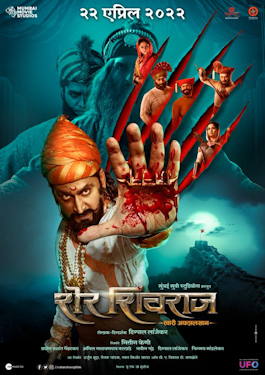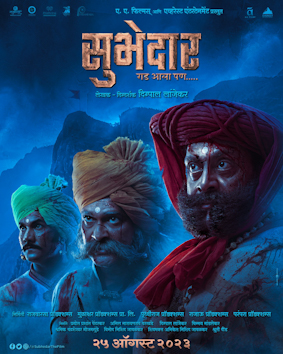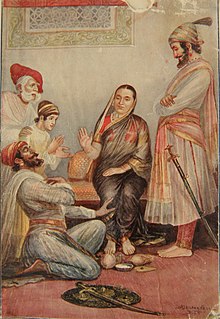
Baji Prabhu Deshpande was a general of the Maratha Army. He is known for his role in the Battle of Pavan Khind at Ghod Khind, where he sacrificed his life defending Shivaji from incoming Adil Shahi forces of Siddi Johar. He also was a landlord or Vatandar in the Maval region.

Sinhagad is an ancient hill fortress located at around 49 km southwest of the city of Pune, India.

Jijabai Bhonsle (or Bhonsale, Bhosale, Bhosle) or Jadhav, referred to as Rajmata, Rastramata, Jijabai, Jijamata or Jijau, was the mother of Chattrapati Shivaji, founder of the Maratha Empire. She was a daughter of Lakhujirao Jadhav of Sindkhed Raja.
The Nayak, or Naik is a historic Indian title conferred on military generals and governors of feudal states in the Middle Ages. Today it is also a surname. Nayaks are mostly Hindu and few Sikhs, who follow Hinduism and Sikhism respectively.

The Battle of Sinhagad, also known as Battle of Kondhana, involved an attack by the forces of the Maratha Empire during the night of 4 February 1670 on the fort of Sinhagad, near the city of Pune, Maharashtra. The Marathas captured the fort.
The powada is a genre of Marathi poetry that was during the late 17th century in India. Powada, which means ‘to glorify’, is a traditional Marathi ballad that traces its history to more than 750 years Powadas often glorified and celebrated deeds of popular folk figures and leaders such as Chhatrapati Shivaji and Tanaji Malusare, and were also written to raise awareness on social issues such as female foeticide, dowry and corruption. Powadas were also used as a medium to create awareness during Samyukta Maharashtra movement.

Sinhagad is a 1933 Marathi historical fact film directed by V. Shantaram. The production company was Prabhat Film Company. The story was based on Hari Narayan Apte's literary classic novel "Gad Ala Pan Sinha Gela". Apte was a famous Marathi novelist of the early twentieth century. The story's screenplay and dialogue were written by Narayan Hari Apte. The cinematographers were V. Avadhoot and Keshavrao Dhaiber. The cast included Master Vinayak, Baburao Pendharkar, Keshavrao Dhaiber, Leela Chandragiri, Shinde, Prabhavati, Budasaheb and Shankarrao Bhosle.

Devdatta Nage is an Indian actor. He gained fame after playing the roles of Lord Khandoba and Bajrang in Jai Malhar and Adipurush, respectively.
Baghtos Kay Mujra Kar is a 2017 Indian Marathi-language political comedy-drama film which is directed by Hemant Dhome. It stars Jitendra Joshi, Aniket Vishwasrao and Akshay Tanksale in lead roles. The film was released on 3 February 2017.

Tanhaji: The Unsung Warrior is a 2020 Indian Hindi-language historical action film, co-written and directed by Om Raut and produced by Bhushan Kumar, Krishan Kumar and Ajay Devgn under T-Series Films and Ajay Devgn FFilms. Tracing the life of Maratha warrior Tanaji Malusare, it stars Ajay Devgn as the eponymous lead, Kajol and Saif Ali Khan. It also features Neha Sharma, Sharad Kelkar and Luke Kenny in supporting roles. Set in the 17th century, it revolves around Tanaji's attempts to recapture the Kondhana fortress once it passes on to Mughal emperor Aurangzeb who transfers its control to his trusted guard Udaybhan Singh Rathore.

Fatteshikast is a 2019 Indian Marathi-language historical drama film directed by Digpal Lanjekar and produced under the banner of Almonds Creations in association with AA Films. The film stars Chinmay Mandlekar, Mrinal Kulkarni, Sameer Dharmadhikari, along with Ankit Mohan and Mrunmayee Deshpande in supporting roles. The music of the film is composed by Devdutta Manisha Baji and the soundtrack includes devotional song of Sant Tukaram. A sequel to Farzand (2018), it is the second film in Lanjekar's Shri Shivraj Ashtak film series in an eight movies series on Maratha Empire. It was followed by the Pawankhind (2022).

Farzand is a 2018 Indian Marathi-language historical drama War film directed by Digpal Lanjekar and produced by Anirban Sarkar under the banner of Swami Samarth Creations LLP. The film was co-produced by Sandip Jadhav, Mahesh Jaurkar and Swapnil Potdar. The film stars Prasad Oak, Ankit Mohan, Chinmay Mandlekar, Mrinal Kulkarni, Mrunmayee Deshpande, Neha Joshi and Sameer Dharmadhikari. It's the first film of the Shri Shivraj Ashtak film series by Lanjekar in an eight part series based on Maratha Empire. It was followed by Fatteshikast in 2019.
Khemirao Sarnaik was a Koli Deshmukh of the Maval region in 1640s, rebelled against Mughal governor Aurangzeb and abolished Jizya.
INS Tanaji stands for the Indian Naval Ship Tanaji and it is a Base Depot ship of the Mankhurd Naval station. It was commissioned by the Chief of the Naval Staff Admiral Nirmal Verma on 10 July 2012 and it acts as a database, human resource unit and career management centre for sailors. INS Tanaji had played a crucial role in the advancements of the Mankhurd Naval Station. The Indian Navy continued its tradition of naming Indian Naval establishments after the great warriors by naming the ship after "Tanaji Malusare". He was a general in the Maratha army of Shivaji and was also alternatively known as the Lion (Simha) for Sinhagad's battle in the 1670's.

Sher Shivraj is a 2022 Indian Marathi-language historical action drama film directed by Digpal Lanjekar and produced by Chinmay Mandlekar, Digpal Lanjekar, Nitin Keni, Pradyot Pendharkar and Anil Warkhade. The film based on the life of Maratha king, Chattrapati Shivaji Maharaj where he defeated Afzal Khan with brilliant tactics and courage stars Chinmay Mandlekar in title role, Mrinal Kulkarni, Ajay Purkar, Mukesh Rishi along with Bipin Surve and Rohan Mankani in supporting roles. The film was released theatrically on 22 April 2022.

Subhedar is a 2023 Indian Marathi-language historical drama film written and directed by Digpal Lanjekar, a fifth installment of Shivraj Ashtak tracing the life of Subedar Tanaji Malusare starring Chinmay Mandlekar, Mrinal Kulkarni, Ajay Purkar in the leading roles. The film is produced by Mulakshar Productions, Raajwarasa Productions, Prithviraj Productions, Rajau Productions, Parampara Productions, and it is distributed by AA Films and Everest Entertainment.
Ajay Ashok Purkar is an Indian actor primarily works in Marathi films. He is best known for portrayed the role of Tanaji Malusare in the Shri Shivraj Ashtak film series.
Shri Shivraj Ashtak is an Indian Marathi-language historical drama film series created by Digpal Lanjekar. The franchise started off with an eight-part film series written and directed by Lanjekar based on Maratha Empire. The first film Farzand released on 1 June 2018 and was followed by 6 films: Fatteshikast (2019), Pawankhind (2022), Sher Shivraj (2022), Subhedar (2023), Shivrayancha Chhava (2024).












